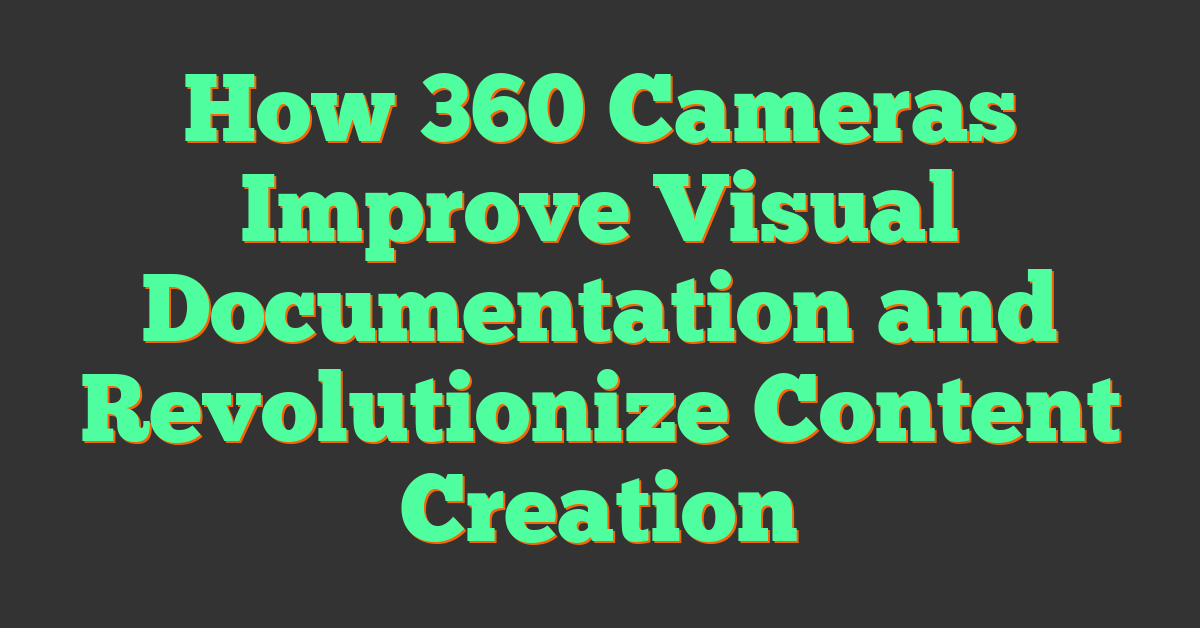Key Takeaways
- 360 cameras revolutionize visual documentation by capturing a complete 360-degree view in a single shot, eliminating blind spots and enhancing storytelling.
- Industries like real estate, education, journalism, and tourism increasingly leverage 360 cameras for virtual tours, immersive training, and engaging content.
- Key benefits of 360 cameras include comprehensive scene capture, greater audience engagement through interactivity, and authentic, true-to-life perspectives.
- Technical challenges include storage demands, low-light performance, and mastering editing tools, but advancements in AI and resolution are steadily mitigating these issues.
- Future innovations such as AR overlays, improved portability, and broader accessibility will drive the adoption of 360 cameras across professional and personal uses.
- As prices decrease and features expand, 360 cameras are becoming indispensable tools for both beginners and seasoned content creators.
Capturing the full picture has never been easier or more immersive than with 360 cameras. These innovative devices are transforming how we document and share visual content, offering a seamless way to record every angle in a single shot. Whether you’re in construction, real estate, or event planning, 360 cameras provide a level of detail and context that’s hard to match.
I’ve seen how traditional photography often leaves gaps in visual storytelling, but 360 cameras eliminate those limitations. They’re not just tools—they’re game-changers for creating comprehensive, engaging, and interactive documentation. Curious about how they’re revolutionizing industries? Let’s dive into the details.
Understanding 360 Cameras
360 cameras transform how moments and spaces are captured by recording a full spherical view in one frame. As someone who has spent years working with and testing these devices, I understand their vast potential for photographers, videographers, and creative professionals.
What Are 360 Cameras?
360 cameras are devices equipped with dual or multiple lenses that capture environments and scenes in a full 360-degree panorama. Unlike traditional cameras, which are restricted to a single perspective, 360 cameras document everything around their position. Popular models like the Insta360 X3 and GoPro Max use advanced image stitching to create seamless, immersive visuals.
Wide accessibility has made these cameras valuable tools for creating virtual tours, immersive videos, and interactive experiences. They support high resolutions, often up to 8K, ensuring high-quality content for both professional projects and casual use.
How Do They Work?
360 cameras operate by using two or more wide-angle lenses, each covering up to 180 degrees of the scene. The camera’s internal software automatically merges—or stitches—these separate images or videos into a single, cohesive spherical output.
I’ve worked with cameras that use advanced features like real-time stitching, offering instant previews, and image stabilization, which ensures smooth footage even in dynamic conditions. Many models are compatible with mobile apps, enabling efficient controls, live streaming, and quick editing. With features like HDR (High Dynamic Range), these devices excel in balancing light and color, enhancing both outdoor and indoor documentation.
By recording in spherical format, 360 cameras provide unparalleled opportunities to craft unique content for platforms like YouTube, Facebook, and virtual reality spaces.
Benefits Of 360 Cameras In Visual Documentation
360 cameras have reshaped the way I approach capturing visuals, blending creativity with cutting-edge technology. Their ability to document scenes entirely transforms how moments and environments are shared.
Capturing Comprehensive Views
« Best Night Vision 360 Cameras for Low-Light Shooting You Can’t Afford to Miss
Top VR 360 Cameras for Stunning Virtual Reality Content You Need to See »
360 cameras record every angle simultaneously, eliminating blind spots. This makes them perfect for scenarios like event coverage, real estate tours, or documenting large-scale projects. For example, during a construction project, a single 360 image can display progress across the entire site, offering clients and teams an efficient update without missing crucial details.
Using high-resolution models like the Insta360 X3, I’ve captured expansive landscapes and immersive city shots that wouldn’t be possible with traditional cameras. These cameras’ wide-angle lenses and stitching software ensure the output is both seamless and detailed.
Enhancing Engagement And Interactivity
By presenting fully immersive visuals, 360 content fosters deeper audience engagement. Viewers gain control over how they explore images or footage, leading to an active viewing experience. When I upload 360 videos to platforms like YouTube or Facebook, I notice the engagement rates outperform standard videos.
Features like real-time stitching and stabilization also make producing interactive media simpler. Virtual reality tours gain a lifelike touch with fluid transitions and stable visuals. For photorealistic experiences, tools like spatial audio can further enhance the immersion.
Providing True-to-Life Perspectives
360 cameras excel in capturing reality as it’s seen by the human eye. Whether it’s the vibrant ambiance of a festival or the intricate interiors of a cathedral, their panoramic abilities ensure nothing is left out.
I rely on HDR modes to balance lighting in challenging environments, like sunset shots or dimly lit venues. By combining accurate textures, depth, and colors, these cameras present visuals that feel authentic and immersive.
Through their ability to document the complete picture, 360 cameras push boundaries in both artistic and informational photography fields.
Applications Of 360 Cameras In Various Fields
360 cameras transform how professionals and enthusiasts capture and experience visuals across multiple industries. Their ability to provide immersive coverage opens up endless possibilities for documentation and storytelling.
Real Estate And Architecture
In real estate and architecture, 360 cameras redefine how spaces are presented. I’ve seen these cameras being used to create virtual tours of properties, letting potential buyers explore homes from anywhere. With platforms supporting 360 content, architects showcase projects with panoramic views to demonstrate layouts, lighting, and spatial arrangements. High-resolution 360 images, like those in 8K, highlight intricate details, making property presentations more dynamic.
Education And Training
360 cameras significantly enhance virtual and remote learning. I’ve used them to record immersive training sessions, allowing users to feel as if they’re physically present in a classroom or professional environment. Industries like healthcare and aviation benefit from 360-degree simulations of complex scenarios, improving trainee engagement. For instance, surgical procedures captured in VR-ready formats provide medical students with a realistic and interactive experience.
Travel And Tourism
The travel and tourism industry leverages 360 cameras to offer potential tourists virtual previews of destinations. When I’ve documented travel spots using my 360 camera, the immersive footage has captivated viewers, making them feel as though they’re on-site. Hotels and tour operators highlight services and locations by sharing interactive content that brings their offerings to life. This storytelling format drives more bookings and boosts user interaction.
Journalism And Media
360 cameras push the boundaries of traditional journalism by creating immersive news stories. I’ve seen journalists use them to document events, protests, and natural disasters, providing audiences with complete, unbiased perspectives. In media production, 360 videos engage viewers by placing them inside the action, whether it’s a live concert, documentary, or breaking news. This approach elevates storytelling and fosters deeper emotional connections.
Challenges Of Using 360 Cameras For Visual Documentation
Despite their benefits, 360 cameras come with challenges that can impact their usability in visual documentation. As someone passionate about 360 photography and videography, I’ve encountered several hurdles that are worth considering.
Technical Limitations
360 cameras rely heavily on advanced technology, but they aren’t without flaws. Image stitching can create visible seams, especially in complex scenes or with moving subjects. Cameras like the GoPro Max and Insta360 X3 have improved stitching, but issues can still arise in high-detail environments.
Low-light performance can also be a problem. Sensors in 360 cameras, often smaller than those in professional DSLR or mirrorless cameras, struggle to capture sharp, noise-free images in dark settings. While HDR and software enhancements help, results often fall short compared to traditional cameras.
Storage and processing requirements are another limitation. High-resolution outputs, such as 5.7K or 8K, produce large files that demand significant storage space and high-performance computers for editing. This can increase costs, especially for professionals managing multiple projects.
Learning Curve For Effective Use
Mastering a 360 camera takes time. Framing, for instance, differs entirely from traditional cameras because every direction is captured simultaneously. Thinking about how viewers will interact with the footage adds complexity.
Understanding editing software is also essential, as post-production often involves advanced tools for stitching, color grading, and exporting. Programs like Adobe Premiere Pro and specialized apps like Insta360 Studio require familiarity, which can be daunting for beginners.
Practical challenges such as positioning the camera to minimize the photographer’s visibility or avoiding tripod shadows need creative solutions. Overcoming these nuances often comes down to trial, error, and experience.
Future Of 360 Cameras In Visual Documentation
360 cameras are at the forefront of visual storytelling, offering unmatched capabilities for immersive content creation. Their future lies in advancing technology and increasing accessibility across industries.
Emerging Trends And Innovations
Future advancements in 360 cameras focus on higher resolutions, AI-driven enhancements, and improved portability. Manufacturers are pushing beyond 8K resolution to deliver unparalleled clarity, crucial for professional filmmakers and virtual reality (VR) creators. AI integration enables features like auto-framing and real-time image correction, simplifying workflows for users at all skill levels. For example, some upcoming models are expected to predictively adapt settings based on the environment.
Another trend is the incorporation of augmented reality (AR) overlays within 360 footage, which could transform virtual tours and training simulations. Water resistance, modular designs, and lighter builds make these devices suitable for capturing extreme sports, underwater scenes, and travel documentaries. Innovations in live streaming through 360 cameras, particularly with VR compatibility, point to a growing demand for interactive and real-time audience experiences.
Potential For Broader Adoption
As costs decrease and user interfaces improve, 360 cameras become more accessible to hobbyists and professionals alike. Educational institutions are integrating them into curricula for film, journalism, and creative arts students, preparing the next generation of content creators. Affordable options like the Insta360 ONE RS are introducing first-time users to immersive visual formats, sparking widespread interest in personal and professional applications.
The integration of 360 cameras into smartphones or action cameras is another key driver of adoption, blending convenience with functionality. More industries will incorporate 360 documentation, from healthcare professionals using it for surgical training to event planners creating interactive previews of venues. Collaboration tools and cloud-based editing platforms streamline content sharing, further encouraging adoption among creatives and businesses seeking engaging media solutions.
Conclusion
360 cameras are reshaping how we capture and share the world around us. Their ability to provide immersive, interactive, and comprehensive visuals has unlocked new possibilities across industries. From creating virtual tours to enhancing storytelling, these devices bridge the gap between creativity and technology like never before.
While challenges like storage demands and a learning curve exist, advancements in AI, resolution, and usability continue to push the boundaries of what’s possible. As they become more accessible, 360 cameras are set to play an even greater role in redefining visual documentation for professionals and enthusiasts alike.















